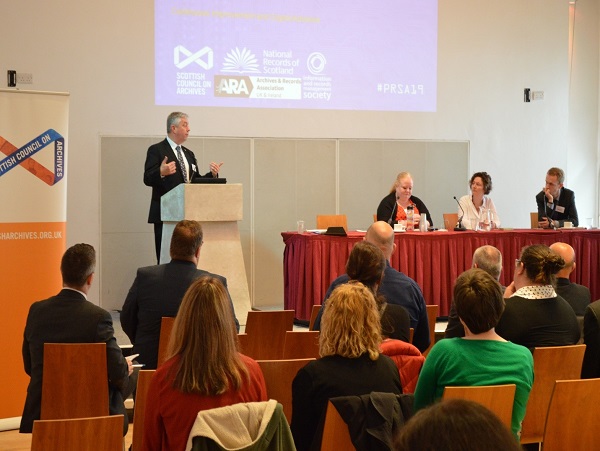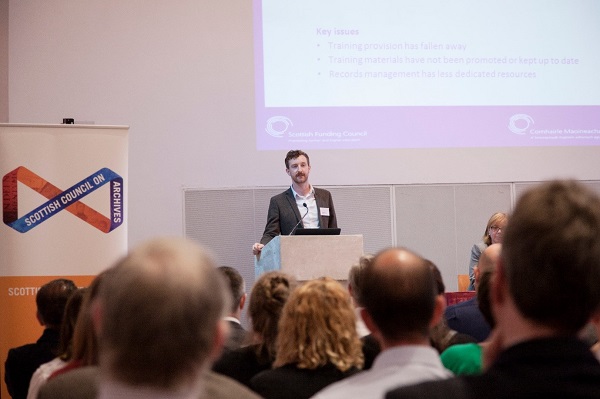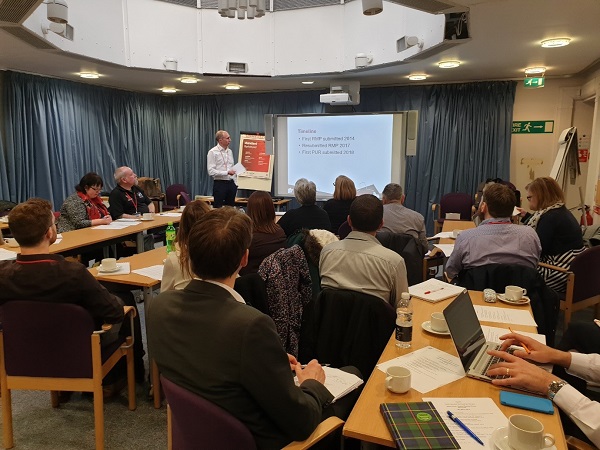2019
2019
August to December 2019
The Assessment Team held a series of surgeries in over the autumn. Three general surgeries, one in Aberdeen and two in Edinburgh, at which we were joined by guest speakers from Food Standards Scotland and West Lothian Council. Two special surgeries were also held, focussing on topics of particular relevance to PRSA implementation. The first addressed the use of SharePoint following the increasing uptake of Microsoft 365 as a records management tool by Scottish public authorities. This surgery was held in Glasgow and was hosted by Skills Development Scotland. We were joined by records management consultants Heather Jack and Frank Rankin, who acted as facilitators. The second special surgery, held in Edinburgh, was specifically for stakeholders working on the records management plans of the 30 Integration Joint Boards in Scotland.
July 2019
At the recent Public Records (Scotland) Act 2011 conference the Assessment Team used the Sli.do app to make the day more interactive. A number of questions were submitted using it which the team were unable to answer on the day. We noted these, however, with a view to answering them after the conference. We have now had a chance to consider them and they can be found below along with our responses.
What would a tougher regulatory regime look like? Could PRSA have more leverage if it the compliance regulatory regime was tougher?
PRSA is enabling legislation which strives to bring about continuous and sustained improvements, therefore the implementation of the Act has involved more carrot than stick. This has been welcomed by the stakeholder community and progress and compliance has been achieved through influencing positive change and collaboration between NRS (the regulator) and scheduled authorities.
NRS has no plans to pursue tougher sanctions for PRSA but will continue to work closely with stakeholders to ensure continuous improvement and lasting changes which support improved business efficiency and excellent stewardship of public records.
Big weakness in RM is lack of staff time to do it. Should we move from organisational controls to investing more in tech controls (e.g. better IT or auto classification)?
Improvements in technological solutions to automation of records management processes will always be welcome, however we recognise that it is the mixture of robust technical solutions and good organisational records management which underpins successful records management. In our experience, organisations with high levels of staff engagement and training of their roles and responsibilities with regard to the records and information they access and manage, are most successful in complying with their many regulatory requirements and public expectations.
Does NRS intend to regularly review the model plan?
Yes, NRS is committed to ensuring the Model Plan and associated guidance meets the needs of PRSA authorities. NRS hosts multiple stakeholder surgeries ever year to ensure regular communication with scheduled authorities. We would anticipate that these surgeries will provide the communication channel by which any such review could and would be initiated if the stakeholder community felt such a review was required. The Keeper will in any case activate a formal review of the Model Plan when he considers it appropriate and to ensure it remains fit for purpose.
How much organisational change has to happen before it is better to submit a new RMP than a large and detailed PUR?
This must be a decision for authorities to make, but it would be wise to liaise with the Keeper’s assessment team to help determine the best option. A rough rule of thumb might be that routine changes to policies or processes should be noted under a PUR and more significant or wholesale changes to an authority’s records management arrangements would merit a resubmission under Section 5(6) of the Act.
With the new Element 15 is there guidance on an “authority’s functions”? Is it only statutory functions or does it include support functions (e.g. IT, HR)?
The Guidance Document which accompanies the model plan has been in operation for 7 years and it too needs revision to ensure it is reflective of the changes made to the revised plan, reflective of the experience of stakeholders’ evidence submitted over the past six years and accommodates the significant change of the addition of element 15. A wholesale review of the guidance will be undertaken during 2019/20, however it is a priority for NRS to develop guidance specific to element 15 in the very near future.
Any records created or held by a third party which do not relate to the statutory functions of the authority covered by the Act are not within the scope of the plan and therefore public authorities are not required to monitor arrangements for these records.
It is not appropriate for the Keeper to determine the functions of each authority. It is the responsibility of the persons named in elements one and two of the plan to identify what these are in line with the statutory underpinning of the authority and ensure records created in the delivery of these functions are covered by the provisions of the plan.
What other tools and resources do we need to develop together? What’s next?
As noted above, NRS will be working on the provision of guidance for element 15 and the revision of model plan guidance in the near future. In response to feedback from the conference we will also be looking to develop topic specific surgery events throughout the year and across Scotland to create a space to discuss and tackle some of the shared issues of concern amongst our stakeholder community.
Beyond this, we are open to any ideas and suggestions of what you think we need to consider. Please let us know at [email protected].
What updates and revision to guidance should accompany the model plan directly dealing with digital record keeping?
Generally, the Model Plan applies to records regardless of medium, however we have made reference to digital issues where these were raised by the stakeholder forum during the review. The review of the accompanying guidance document will address digital issues, and again we would welcome any suggestions from stakeholders as to the particular areas of concern they would like to see covered by the guidance.
Who is responsible for identifying information to archive? Records Manager? Information Asset Owner? Individual staff?
The identification of records of enduring value which should be archived, is one which is made by consultation with all these people and, most importantly, the authority’s archive provider. The development of a retention schedule should take into account the regulatory value of the a record, the business needs, the informational and historical value of the record to the organisation and to the Scottish citizens who have an investment in the public records for which we are all responsible. These interests should be explored when determining retention periods for records, including identification of records of enduring historical value.
June 2019

Friday 31st May saw the third Public Records (Scotland) Act 2011 conference take place at City Halls, Glasgow. The event was fully booked and over 100 attendees braved the rainy weather to hear colleagues talking about Building on the Success of the Public Records (Scotland) Act.
The Conference was opened by the Cabinet Secretary for Culture, Tourism and External Affairs, Fiona Hyslop, who reflected on the origins of the Act and highlighted the importance of partnership and collaboration by the ‘Guardians of the Galaxy’!! She clarified that colleagues in the records management profession are superheroes who protect the authenticity and truth contained in public sector record keeping and this is critical in building and maintaining the trust of the citizens of Scotland.
The Keeper of the Records of Scotland, Paul Lowe, continued on this theme and further emphasised the importance of collaboration and continuous improvement, and the role of records management in holding public authorities accountable to the people they serve.
Hugh Hagan, Senior Public Records Officer, described the recent revision of the Model Plan, and how engagement with the records management community has strengthened the Model Plan. Hugh also made the point that this is evidence that colleagues are taking ownership of the Act: making the Act work for them rather than simply complying with it.
Elspeth Reid, Project Archivist, reminded us about the Progress Update Review (PUR) which is about self-assessment and evidence of continuous improvement. The PUR mechanism was requested by colleagues as a way of informing the Keeper of the progress they are making, so is another example of records managers in Scotland developing solutions that work for them.

Then followed two case studies from practitioners. Callum Morrison from the Scottish Funding Council highlighted the dangers of complacency and the impact that a change of circumstances can have on a records management programme. Meic Peirce Owen from Fife Council described using the PUR mechanism as a way of measuring the maturity of records management provision within his authority.
The afternoon session was devoted to digital records and their preservation, which is hugely important in the sector as more and more services are delivered digitally. Rachel Dowle spoke about the Scottish Government’s commitment to open government based on transparency, information sharing and accountability. Information is critical to helping to achieve this and it is essential that this information is managed properly.
Sharon McMeekin from the Digital Preservation Coalition described the essentials for digital preservation, the main one being having a digital preservation strategy, but also outlined other tools, methods and resources to help manage and preserve records.
Garth Stewart, Head of Digital Records Unit at NRS, encouraged us not to feel overwhelmed by the quantity of digital records in our organisations. He also emphasised the importance of websites in forming part of the public record, and described how NRS’ Web Continuity Service can archive the websites of public authorities.
Tim Gollins, Head of Preservation and Information Management at NRS, rounded the talks off with a list of key things to remember about digital preservation. Some of the key points from his presentation were: that records must outlive any IT system; it is critical to test data export at the start; to use common file formats; to understand sensitive records; and to know what you have got.
The theme running through the day was the three Cs – collaborate, communicate and celebrate. It was great to see colleagues engaging with NRS staff and the other speakers throughout the day and, more importantly, with each other. Many thanks to the Scottish Council on Archives, Archives and Records Association Scotland, and the Information and Records Management Society for helping to pull together an excellent day.
April 2019
The Keeper’s Public Records (Scotland) Act 2011 (PRSA) Assessment Team has recently completed the spring series of surgeries for 2019. The first two surgeries took place on 26 and 28 March in Edinburgh and Paisley, respectively. These provided an opportunity for the Team to inform colleagues from public authorities on what has been happening over the last few months, with updates on the review of the Model Plan, the Progress Update Review (PUR) mechanism, the upcoming PRSA conference and also reflecting on progress since PRSA came into force in January 2013. These surgeries were well attended with representatives from 38 public authorities travelling from Inverness and Dumfries, and everywhere in-between. They contributed to interactive discussions and enjoyed the opportunity to network with colleagues from across the Scottish public sector. Attendees also learned from guest speakers from the Scottish Parliament and Police Scotland who had taken part in the PUR process and were willing to share their experiences.

On 2 April the Team hosted the first ‘newcomers’ surgery. This was a chance for the Team to engage with colleagues who had become their authority’s records manager since the original Records Management Plan (RMP) was agreed by the Keeper and also for those who are yet to submit their RMP. The surgery was also well attended with representatives from 15 authorities, with one travelling from Orkney. Again, it afforded the prospect of networking with colleagues in the same situation as well as finding out the requirements in submitting and maintaining a RMP. This was assisted by a presentation from Dumfries and Galloway Council, who have had two RMPs agreed!
The Team are still evaluating the responses to the formal public consultation on the proposed revision of the Keeper’s Model Plan and will hopefully be in a position to publish this soon. The accompanying Guidance Document will also need to be updated in line with the changes to the Model Plan.
The Team are also planning to issue a short electronic survey to the key contacts in each public authority. We are keen to try and identify the impact of PRSA on the levels of records management provision within Scottish public authorities and would be grateful if colleagues could complete the survey. The survey should be issued by the middle of April.
PDF files require Acrobat Reader. Download Acrobat Reader free: 